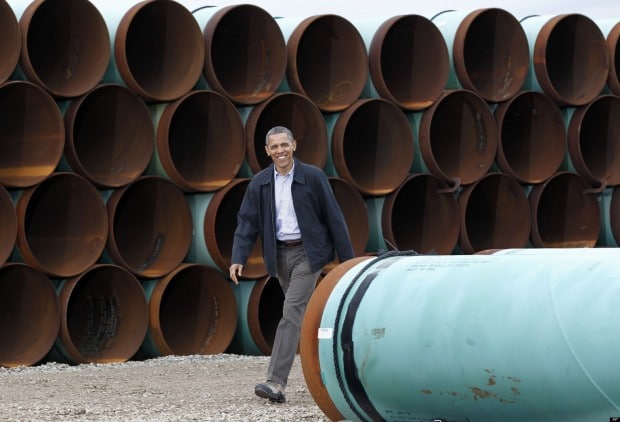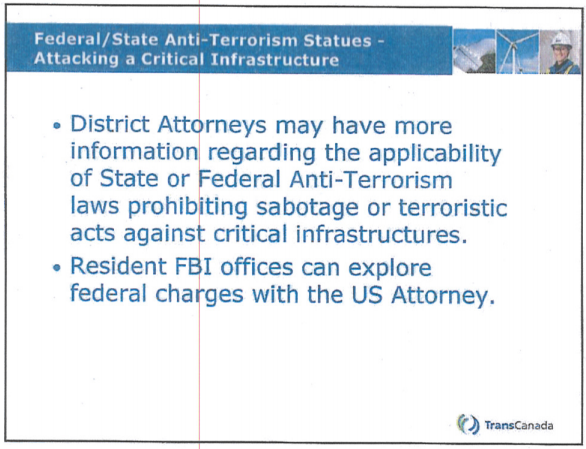Dave Cooper, Command Master Chief SEAL (Retired) for the Naval Special Warfare Development Group (DEVGRU), has authored a threat assessment concluding TransCanada‘s Keystone XL tar sands pipeline is potentially at-risk of a terrorism attack.
In the report, Cooper concluded operational security vulnerabilities for the pipeline have been overlooked by the U.S. government. Cooper — most famous for overseeing the Abbottabad, Pakistan Osama Bin Laden raid as the commander of Navy SEAL Team Six — wrote the report as a consultant for billionaire Tom Steyer‘s advocacy group NextGen Climate Action.
“The very nature of Keystone XL’s newsworthiness, should it ever be built, increases its attractiveness as a target to terrorists: Keystone XL, aside from being a ‘soft’ target just like any other pipeline, has a built-in emotional impact that can’t be denied or wished away,” he wrote in the report’s introduction.
“That simple fact, a newsworthy proposal that engenders strong passions, should clue in pipeline owners and government officials to the very real possibility of intentional attack.”
For the report, Cooper utilized a “red cell” methodology, parlance for U.S. special operations forces performing pre-mission reconnaissance, using open source data readily available to terrorists on the internet. In so doing, the special operations forces snuff out operational security (“OpSec” in military lingo) weaknesses, which they use as actionable intelligence in defense missions.
In the report, Cooper explained he “designed [the methodology this way] to showcase weaknesses in the current reality by exploiting the same information to which an outside terrorist group would have access.”
Cooper’s probe included a due diligence trip out three redacted Great Plains locations*, where Phase I of the Keystone Pipeline System is currently operational (the northern leg of Keystone XL is Phase IV). Going out into the field, Cooper came away shocked by his discoveries.
His findings raise a troubling question: have real Keystone XL terrorism threats been ignored, while non-violent activists have been labeled potential eco-terrorists? Cooper offered his take on this question to DeSmogBlog.
“No Sight” of Active Security Program
Cooper said he mapped out his entire Nebraska trip by using a maps of the Keystone Pipeline System he found online.
“In military parlance, the site visit at [redacted] was a ‘cold shot,’ done with no advance preparation or planning, using only information and intelligence gathered from publicly available sources,” wrote Cooper.
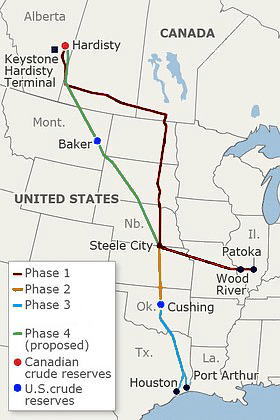
TransCanada Keystone Pipeline System; Image Credit: Wikimedia Commons
“[redacted] was selected because it has both a valve and pumping station for the operational Keystone 1, it is somewhat near Keystone XL’s route, and it is roughly similar to the proposed Keystone XL – with presumably the same level of security as the proposed pipeline.”
Once on the ground, Cooper found absolutely nothing indicating an active security program.
“I was able to freely approach, then stand at a Keystone 1 pump station for over 15 minutes snapping photos,” he wrote. “I was not approached, questioned or even noticed at any point.”
Cooper concluded that in a worst case scenario, a dozen terrorists could cause a seven million gallon spill by attacking the pipeline at three points. And that’s if TransCanada were to have perfect execution of shut-down protocol.
KXL and FBI/DHS Fusion Centers
In concluding his report, Cooper pays homage to domestic intelligence agencies for practicing predictive policing.
“This assessment also cannot speak for the innumerable and valiant efforts of our intelligence agencies, those who strive daily to defeat terrorists ‘upstream’ before they can actually act on their designs,” wrote Cooper. “Their persistent actions in our defense could very well thwart any such pipeline attack during the terrorists’ observation, orientation and decision phases.”
DeSmogBlog has reported on these predictive policing efforts as it pertains to Keystone XL. And the results, put mildly, haven’t been pretty.
Documents obtained by Bold Nebraska and reported on here in June 2013 revealed TransCanada and the Nebraska-based Department of Homeland Security (DHS)/U.S. Federal Bureau of Investigations (FBI) Fusion Center labeled non-violent activists as possible candidates for terrorism charges and other serious criminal charges.
This tension existing between protecting national security and protecting civil liberties brings ire to Shahid Buttar, executive director for the Bill of Rights Defense Committee.
“Throughout the 1990s, the principal targets of US counter-terror investigations were environmental activists who planned non-violent acts,” he told DeSmogBlog.
“If the northern leg of Keystone XL pipeline becomes operational, the security concerns of fossil fuel companies could be used once again, like they were in Pennsylvania only a few years ago, to justify government intelligence agencies undermining the constitutional rights of environmentalists to peacefully organize and dissent.”
Asked about these concerns by DeSmogBlog, Cooper agreed with Buttar.
“The focus on protesters and activists is somewhat shortsighted,” he said. “It’s not like activism is a gateway drug to terrorism and it amounts to profiling (like racial profiling). Just following around protesters or activists isn’t the answer. What you see is all there is.”
“An activist’s intentions typically revolve around disobedience in all its forms. While most might get arrested, it’s typically for stuff like trespassing. A real mean bunch!”
A recent historical case study and parallel is also instructive and sobering.

Boston Marathon bombers Dzhokhar Tsarnaev and Tamerlan Tsarnaev; Photo Credit: Wikimedia Commons
The Boston-based FBI/DHS Fusion Center poured massive amounts of resources into monitoring Occupy Boston activists rather than the would-be Boston Marathon bombers, as revealed in a May 2013 investigative report published by NBC News.
Mr. Cooper Goes to Washington
According to an article appearing in National Journal, Cooper has already presented his findings to both U.S. Sen. Barbara Boxer (D-CA) and U.S. Sen. Martin Heinrich (D-NM).
NextGen spokesman Mike Casey told DeSmogBlog that NextGen also delivered a copy of the report to Carlos Pascual, Special Envoy and Coordinator for International Energy Affairs for the U.S. State Department.
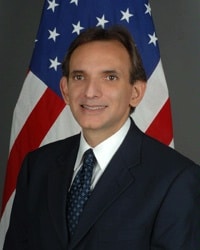
Carlos Pascual, U.S. State Department Special Envoy and Coordinator for International Energy Affairs; Photo Credit: U.S. State Department
The letter delivery — as opposed to an actual meeting — took place after Pascual cancelled a meeting they had set late on the afternoon of Friday, May 30. They had planned to meet the following Monday.
NextGen has provided DeSmogBlog with a copy of that tersely-crafted email.
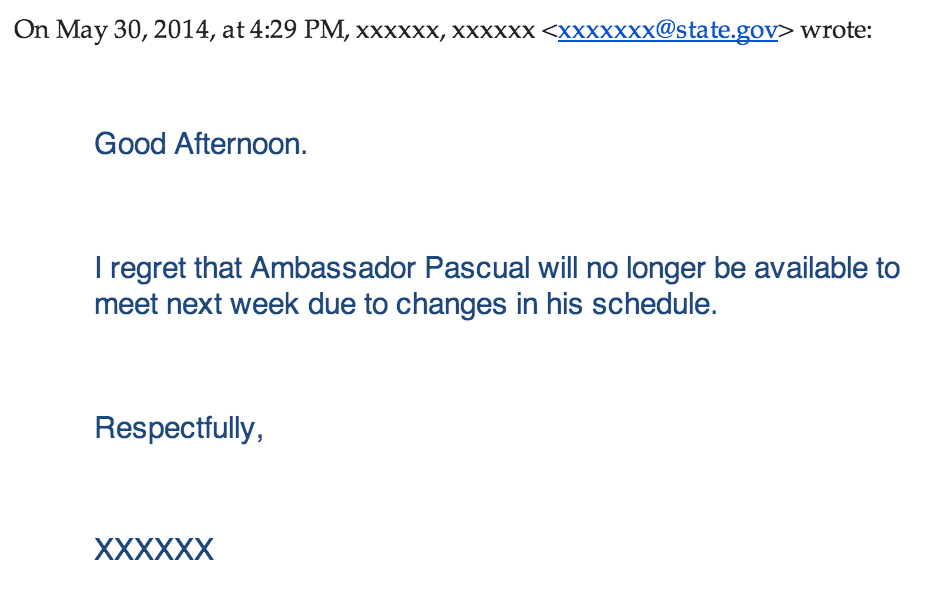
According to Casey, the State Department told NextGen the next opening it had for a meeting was in mid-August.
“The State Department’s review of the Presidential Permit application for the proposed project – and the ultimate determination of whether granting a permit serves the national interest – will take a number of factors into consideration, including the national security of the United States,” the State Department told The Huffington Post.
“Serious National Conversation”
Cooper concluded the threat assessment by highlighting why he took on the study.
“My goal in releasing this version of the assessment is to provide federal officials and the public with the information on this vulnerability to take it into account – and take steps to address it,” he said in a press release provided to DeSmogBlog. “We need a serious national conversation about what we do to head off an attack.”
But this is also a tale about where best to pool resources — and where not to — in the name of national security. Cooper has opened a new chapter in the ongoing saga that is the debate over Keystone XL‘s northern leg.
*An earlier version of this story said Cooper visited the Sand Hills. The locations he visited are redacted for national security purposes. We regret the error.
Subscribe to our newsletter
Stay up to date with DeSmog news and alerts


